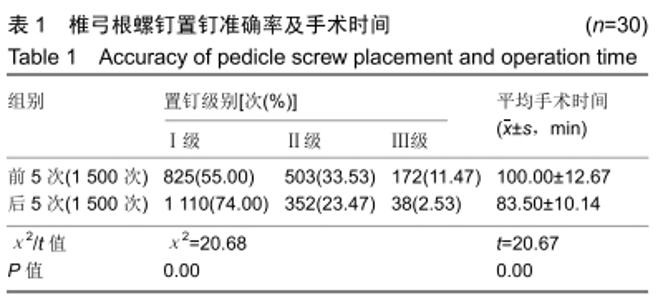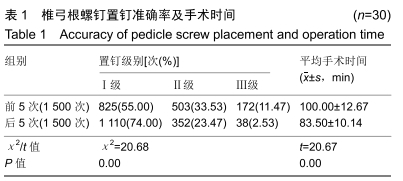[1] CHA JR, KIM YC, JANG C, et al. Pedicle screw fixation and posterior fusion for lumbar degenerative diseases: Effects on individual paraspinal muscles and lower back pain; a single-center, prospective study.BMC Musculoskelet Disord. 2016;17:63.
[2] LOPEZ G, WRIGHT R, MARTIN D, et al.A cost-effective junior resident training and assessment simulator for orthopaedic surgical skills via fundamentals of orthopaedic surgery.J Bone Joint Surg Am. 2015; 97(8):659-666.
[3] GARG B, MEHTA N. Current status of 3d printing in spine surgery.J Clin Orthop Trauma. 2018;9(3):218-225.
[4] 吴超,邓佳燕,谭伦,等.复合型3D打印导航模板辅助枢椎椎弓根或椎板置钉的临床研究[J].中国脊柱脊髓杂志, 2018,28(11):982-988.
[5] 王飞,刘志斌,张建华,等.3D打印导航模板在辅助寰枢椎椎弓根螺钉置入中的应用价值[J].中国脊柱脊髓杂志,2017,27(1): 61-68.
[6] 阳宏奇,雷青,蔡立宏,等.3D打印导板辅助空心螺钉内固定治疗不稳定性骨盆骨折[J].中国修复重建外科杂志,2018,32(2): 145-151.
[7] JONES DB, SUNG R, WEINBERG C, et al.Three-dimensional modeling may improve surgical education and clinical practice.Surg Innov. 2016;23(2):189--195.
[8] 王碧菠,陈博,李星辰,等.3D打印距骨部件修复重建距骨病损的生物力学研究[J].中国修复重建外科杂志,2018,32(3): 306-310.
[9] 张峰,李宇欢,牛斌斌,等.山羊可动腰椎复合体的设计及体外生物力学研究[J].中国脊柱脊髓杂志,2017,27(4): 345-352.
[10] WU AM, LIN JL, KWAN KYH, et al. 3D-printing techniques in spine surgery: the future prospects and current challenges.Expert Rev Med Devices. 2018;15(6):399-401.
[11] PARK HJ, WANG C, CHOI KH, et al.Use of a life-size three- dimensional-printed spine model for pedicle screw instrumentation training.J Orthop Surg Res. 2018;13(1):86.
[12] BURKHARD M, FÜRNSTAHL P, FARSHAD M.Three-dimensionally printed vertebrae with different bone densities for surgical training.J Orthop Surg Res. 2018;13(1):86.
[13] 李明,孙亮,马腾,等.3d打印快速成型技术在髋臼骨折分型及年轻医生培养中的应用[J].中华创伤骨科杂志,2017,19(2): 140-145.
[14] BOHL MA, MOONEY MA, REPP GJ, et al.The Barrow Biomimetic Spine: Fluoroscopic analysis of a synthetic spine model made of variable 3D-printed materials and print parameters.Spine (Phila Pa 1976). 2018;43(23):E1368-E1375.
[15] CRAMER J, QUIGLEY E, HUTCHINS T, et al.Educational material for 3d visualization of spine procedures: Methods for creation and dissemination.J Digit Imaging. 2017;30(3):296-300.
[16] KAWAGUCHI Y, NAKANO M, YASUDA T, et al.Development of a new technique for pedicle screw and Magerl screw insertion using a 3-dimensional image guide.Spine. 2012;37(23):1983-1988.
[17] RAO G, BRODKE DS, RONDINA M, et al.Inter- and intraobserver reliability of computed tomography in assessment of thoracic pedicle screw placement.Spine (Phila Pa 1976).2003;28(22):2527-2530.
[18] ZHONG YZ, WEI FY, YONG XS, et al.Case control study on two different surgical approaches combined fixation with lumbar interbody fusion for the treatment of single segmental lumbar vertebra diseases. Zhongguo Gu Shang. 2017;30(5):417-425.
[19] ARTS MP, KURŠUMOVIC A, MILLER LE, et al.Comparison of treatments for lumbar disc herniation: Systematic review with network meta-analysis.Medicine (Baltimore). 2019;98(7):e14410.
[20] GIRARDO M, CINNELLA P, GARGIULO G, et al.Surgical treatment of osteoporotic thoraco-lumbar compressive fractures: the use of pedicle screw with augmentation PMMA.Eur Spine J.2017;26(Suppl 4):546-551.
[21] TSCHUGG A, KAVAKEBI P, HARTMANN S.Clinical and radiological effect of medialized cortical bone trajectory for lumbar pedicle screw fixation in patients with degenerative lumbar spondylolisthesis study protocol for a randomized controlled trial (mPACT).Trials. 2018;19(1): 129.
[22] WANG H, LIU Y, ZHAO Y, et al.Feasibility and accuracy of computer- assisted individual drill guide template for minimally invasive lumbar pedicle screw placement trajectory.Injury. 2018;2(11):7588-7593.
[23] SHAO ZX, HE W, HE SQ, et al.A 3D navigation template for guiding a unilateral lumbar pedicle screw with contralateral translaminar facet screw fixation: a study protocol for multicentre randomised controlled trials.BMJ Open. 2017;7(7):e016328.
[24] 刘政,李宏伟,王爽 .胸腰椎椎弓根螺钉置入技术的比较分析与展望[J].中国组织工程研究,2017,21(19):3102-3107.
[25] EVAN L, TIMUR U, STEVEN V.Percutaneous Instrumentation of a Complex Lumbar Spine Fracture with Bilateral Pedicle Dissociation: Case Report and Technical Note.J Neurol Surg A Cent Eur Neurosurg. 2018;79(5):416-423.
[26] MOHANTY SP, BHAT SN, PAI KANHANGAD M, et al.Pedicle screw fixation in thoracolumbar and lumbar spine assisted by lateral fluoroscopic imaging: a study to evaluate the accuracy of screw placement. Musculoskelet Surg. 2018;102(1):47-55.
[27] ZHANG D, GAO X, JIANG J, et al.Safe placement of pedicle screw in lumbar spine with minimum three year follow-up: a case series and technical note.Int Orthop. 2018;42(3):567-573.
[28] PRAVEEN S, KOJO H, MICHAEL T, et al.Thoracic, Lumbar, and Sacral Pedicle Screw Placement Using Stryker-Ziehm Virtual Screw Technology and Navigated Stryker Cordless Driver 3: Technical Note.J Clin Med. 2018;7(4). pii: E84.
[29] DU JY, KIELY PD, AL MAAIEH M, et al.Lateral lumbar interbody fusion with unilateral pedicle screw fixation for the treatment of adjacent segment disease: a preliminary report.J Spine Surg 2017;3(3): 330-337.
[30] HIROTO K, SHINICHI Y, KAZUTAKA U, et al. Advantages and Disadvantages of Multi-axis Intraoperative Angiography Unit for Percutaneous Pedicle Screw Placement in the Lumbar Spine.Neurol Med Chir (Tokyo). 2017;57(9):481-488.
[31] WANIBUCHI M, NOSHIRO S, SUGINO T, et al. Training for skull base surgery by using a colored temporal bone model created by three- dimensional printing technology.World Neurosurg. 2016;91:66-72.
[32] WU AM, SHAO ZX, WANG JS, et al.The Accuracy of a Method for Printing Three-Dimensional Spinal Models.PLoS One. 2015;10(4): e0124291.
|

